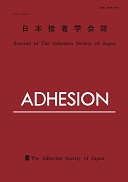
- |<
- <
- 1
- >
- >|
-
Katsuya HIMURO, Motoyasu ASAKAWA, Kenichi YAMAMOTO2017 Volume 53 Issue 8 Pages 283-289
Published: August 01, 2017
Released on J-STAGE: October 02, 2018
JOURNAL FREE ACCESSDownload PDF (5730K)
-
Yuya TACHIBANA, Senri HAYASHI, Ken-ichi KASUYA2017 Volume 53 Issue 8 Pages 276-282
Published: August 01, 2017
Released on J-STAGE: October 02, 2018
JOURNAL FREE ACCESSDownload PDF (2377K)
-
Masayo NODA, Kazuki TAKAKURA, Shun OKADA, Syuji FUJII, Yoshinobu NAKAM ...2017 Volume 53 Issue 8 Pages 268-275
Published: August 01, 2017
Released on J-STAGE: September 28, 2018
JOURNAL FREE ACCESSPressure-sensitive adhesive (PSA) is a typical viscoelastic material, therefore the test rate dependenciesof tensile and adhesion properties were compared. For this purpose, the effects of both crosslinking agentconcentration and tensile test rates on the tensile properties of PSA composed of crosslinked poly(n-butylacrylate-acrylic acid) with an acrylic acid content of 5 wt% were determined. Tensile test rates ranging from1.7 × 10-2 to 5 mm・s-1 were applied, and the resulting data were compared with the adhesion properties ofthe PSA. The 100% modulus was found to increase with increasing crosslinking agent content and with fastertensile test rates. In contrast, the maximum stress and the elongation at break showed maximum values atspecific crosslinking agent levels, and these peak values shifted depending on the rate. The 90º peel strengthof the PSA was measured over the peel rate range from 1.7 × 10-2 to 5 mm・s-1, and was observed to increasewith greater degrees of crosslinking and with faster peel rates under those conditions associated with cohesivefailure. Conversely, the peel strength increased with faster peel rates, whereas it decreased with an increase incrosslinking degree under the condition of interfacial failure. The higher 100% modulus lowered the interfacialadhesion. The 100% modulus affected strongly on the peel strength.
View full abstractDownload PDF (6449K)
-
Nobuya SATO, Tomoya SUGIKI, Eisuke YAMADA2017 Volume 53 Issue 8 Pages 262-267
Published: August 01, 2017
Released on J-STAGE: September 28, 2018
JOURNAL FREE ACCESSThe authors investigated physical properties of epoxy resins modified by various blend ratio of PUR(Polyurethane Resin) and PUE( Polyurethane Elastomer). PUR and PUE were synthesized in epoxy by usingthe same method in the previous paper, respectively. PUE was made from poly( oxytetramethylene) glycol(PTMG;MW:2000), 4,4'-diphenylmethanediisocyanate( MDI) and 1,4-butanediol( BD), and PUR made fromPTMG1000 had many amounts of hard segment which was composed of MDI and BD in chemical structure ofpolyurethane.The results of SEM showed that the diameter of PU particle dispersed in epoxy resins modified by PUE wasbigger than one of PUR system, and PUE system changed into co-continuous structure with increasing in theamount of PUE. The morphology of all epoxy resins modified by PUR and PUE blends showed micro phaseseparation structures of the sea and island type, the PU particle sizes of them became much finer diameterthan PUE system.Regarding physical properties in all aspects, T-peel strength of 3 blends system increased at 20~30phramount ,especially the strength at blend ratio 1/1 of PUR/PUE showed drastic increase. Tensile shearstrength, bending properties and fracture toughness were kept relative high value without deterioration at thehigh amount region. Furthermore, these physical properties except T-peel strength indicated the remarkableresemblance behavior per amount of the blends without dependence on the blend ratio.
View full abstractDownload PDF (3057K)
- |<
- <
- 1
- >
- >|